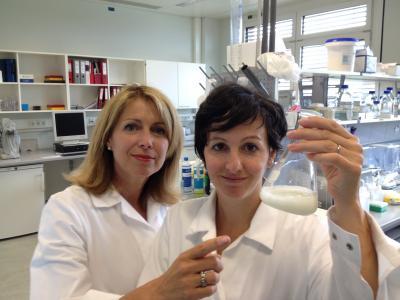People allergic to milk often assume they have lactose intolerance, but they are actually different mechanisms that occur in different parts of the body.
People with lactose intolerance do not digest lactose properly because they lack an enzyme known as lactase - and that results in digestive discomfort. A cow milk allergy is much more dangerous because the body's immune system attacks milk proteins with its own IgE antibodies.
According to statistics, up to 2-3 percent of children in Europe suffer from an actual milk allergy, though it often disappears in adulthood. In those children, formation of Th2 lymphocytes is initiated in these patients and Th2 lymphocytes contribute in great measure to the production of IgE antibodies to milk proteins. Hence, they develop an allergic reaction to milk.

Erika Jensen-Jarolim and Franziska Roth-Walter. Photo: Erika Jensen-Jarolim/Vetmeduni Vienna
A milk allergy may cause swelling of the mouth and mucous membranes, diarrhea, exacerbation of neurodermitis, and in rare cases even an allergic shock. Precise diagnostic investigation helps to differentiate between allergy and intolerance and thus avoid incorrect diets which, under certain circumstances, may cause malnutrition.
Lack of iron load transforms milk protein into allergen
One of the most important milk allergens, beta-lactoglobulin, belongs to the protein family of lipocalins. Lipocalins possess molecular pockets which are able to accommodate iron complexes. Iron is bound to the protein by so-called siderophores.
First author Franziska Roth-Walter
the department of Comparative Medicine at the Messerli Research Institute
and colleagues found that an "empty" milk protein, one without iron and siderophores, helps to activate Th2 lymphocytes. As a consequence, the production of IgE antibodies against the milk protein is stimulated. The patient gets sensitized and may develop an allergic reaction to milk. "Knowledge of the molecular structure of allergens has contributed very significantly to our conclusion about milk allergy. This is of enormous practical relevance."
Does organic milk matter?
As the next step the scientists want to find out, what contributes to the iron load of milk proteins. Lead investigator Erika Jensen-Jarolim says, "One of the most burning questions we want to answer is: Why are these milk proteins loaded to a greater or lesser extent with iron? The manner of keeping and feeding cows may be a factor involved in this phenomenon. Iron loading may depend on whether the milk is produced organically or conventionally. This will be one of our major interests in the future. Lipocalins exist in all mammals. We assume that our conclusions will be applicable to the milk of other mammals as well."





Comments